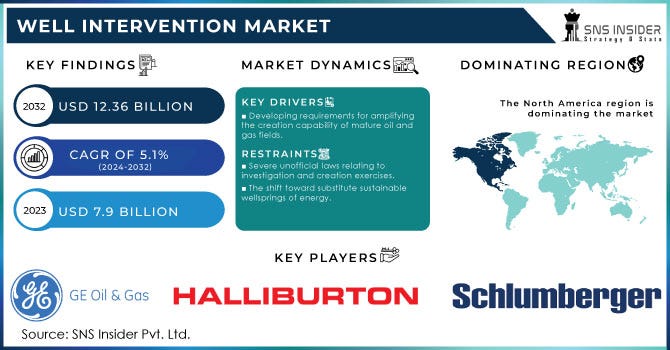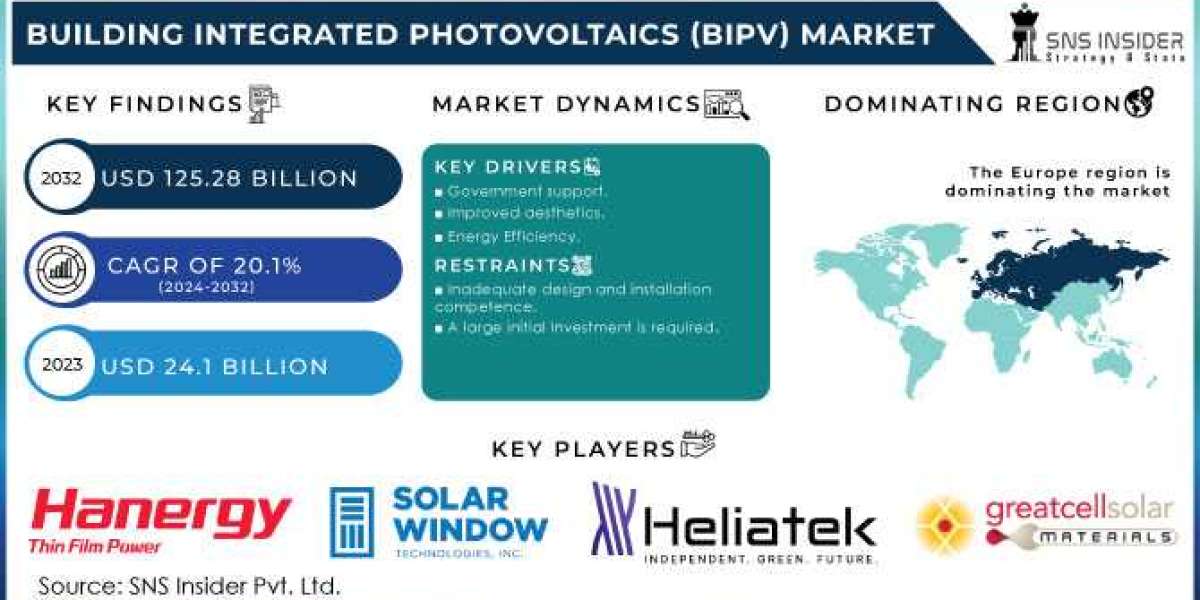
The Well Intervention Market Size was esteemed at USD 7.9 billion in 2023 and is supposed to arrive at USD 12.36 billion by 2032 and develop at a CAGR of 5.1% over the forecast period 2024–2032.
The global well intervention market is expected to witness substantial growth over the next decade, driven by the increasing need for maximizing the production efficiency of oil and gas wells, rising global energy demand, and ongoing technological innovations in well services. As oil and gas companies look to extend the life of mature wells and enhance hydrocarbon recovery rates, well intervention services are becoming more crucial than ever.
Well intervention refers to a range of services that are performed to maintain, repair, or enhance the production of an oil or gas well. These services include well maintenance, well stimulation, logging, re-perforation, and plugging. Well intervention activities are essential for sustaining production from mature wells and for optimizing production performance from new wells.
As the global oil and gas industry faces growing pressure to improve productivity and cost-efficiency, well intervention services are emerging as a critical tool for extending the lifespan of wells and increasing production output. The market is benefiting from the rising global energy demand and the growing focus on offshore oil and gas exploration, where intervention services are essential for maintaining well integrity and performance.
Current Trends
Several key trends are shaping the well intervention market, including:
- Increased Focus on Offshore Exploration: Offshore oil and gas fields are a key focus area for major energy companies due to their vast untapped reserves. As offshore wells tend to be more expensive and complex to drill, well intervention services are crucial for maximizing returns on investment and improving production efficiency.
- Growing Number of Mature Wells: With many oilfields around the world entering their maturity phase, operators are increasingly relying on well intervention services to maintain production levels and extend the operational life of wells. This trend is particularly prominent in regions such as North America and the North Sea, where many wells are reaching the end of their primary production phase.
- Technological Advancements: Innovations in coiled tubing, wireline services, and hydraulic fracturing are enabling more efficient and cost-effective well intervention activities. The development of advanced tools and techniques is helping to reduce downtime, minimize well damage, and optimize production, particularly in offshore environments where well intervention costs are typically higher.
- Environmental and Safety Regulations: The growing emphasis on environmental sustainability and safety in the oil and gas industry is driving demand for more precise and efficient well intervention techniques. Companies are increasingly adopting low-impact intervention methods that minimize environmental disturbances while ensuring well integrity and safety.
- Shift Toward Digitalization: The integration of digital technologies such as real-time data analytics, remote monitoring, and automated systems is transforming the well intervention landscape. These technologies are helping operators to enhance the efficiency of intervention activities, reduce costs, and improve decision-making processes.
Segmentation Analysis
By Type
- Light Well Intervention: These services involve wireline and slickline operations to monitor well performance, adjust downhole valves, and conduct basic maintenance. Light interventions are typically less expensive and are used for well diagnostics and low-complexity tasks.
- Medium Well Intervention: Medium interventions involve coiled tubing operations, which allow for more complex tasks such as cleaning, scale removal, and acid stimulation. Coiled tubing is highly versatile and is widely used for both onshore and offshore well interventions.
- Heavy Well Intervention: These services involve snubbing, fishing, and workover operations that are used to address major well issues such as casing repairs, tubing replacements, and re-completion activities. Heavy interventions are more complex and expensive, but are essential for revitalizing aging or damaged wells.
By Service
- Logging and Bottomhole Survey: These services involve the use of wireline tools to gather critical data about well conditions, including temperature, pressure, and formation characteristics. Logging services help operators assess well performance and identify areas for improvement.
- Stimulation: Well stimulation services, such as acidizing and hydraulic fracturing, are designed to enhance well productivity by increasing the permeability of the reservoir rock. Stimulation is particularly important for wells in tight formations or those experiencing a decline in production.
- Re-perforation: Re-perforation involves creating new perforations in the well casing to access previously untapped reservoirs or improve the flow of hydrocarbons. This service is essential for maximizing production from mature wells.
- Sand Control: Sand control services are used to prevent the production of sand from the reservoir, which can damage equipment and reduce well performance. Gravel packing and sand consolidation techniques are commonly used to address this issue.
- Others: Other well intervention services include plug and abandonment (PA), tubing replacement, and wellhead repair, all of which are essential for maintaining well integrity and ensuring safe operations.
By Application
- Onshore: Onshore wells, which are typically easier and less expensive to access, account for a significant portion of well intervention activities. The onshore sector includes interventions in both conventional and unconventional oil and gas wells.
- Offshore: Offshore well interventions are more complex and costly, but they are crucial for maintaining production in deepwater and ultra-deepwater wells. The offshore sector is expected to grow rapidly, driven by rising investments in offshore exploration and production activities.
The well intervention market is poised for steady growth, driven by the need to extend the life of mature wells and enhance production efficiency in both onshore and offshore fields. Technological advancements in well intervention tools and services, along with rising investments in offshore exploration, are expected to play a key role in market expansion.
About Us:
SNS Insider is a global leader in market research and consulting, shaping the future of the industry. Our mission is to empower clients with the insights they need to thrive in dynamic environments. Utilizing advanced methodologies such as surveys, video interviews, and focus groups, we provide up-to-date, accurate market intelligence and consumer insights, ensuring you make confident, informed decisions.
Contact Us:
Akash Anand — Head of Business Development Strategy
info@snsinsider.com
Phone: +1–415–230–0044 (US) | +91–7798602273 (IND)














